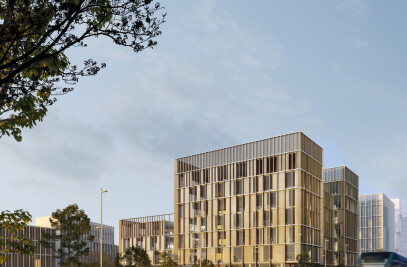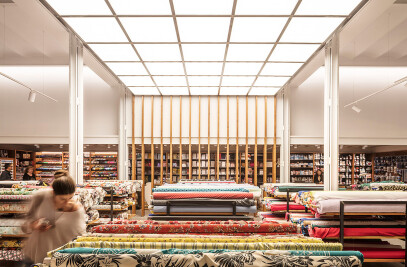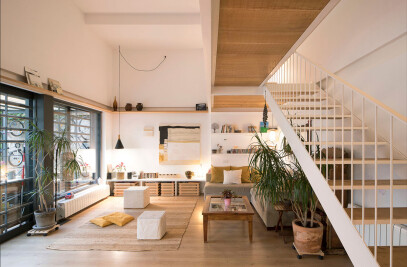A forefront scientist facility integrated into the natural environment. The building focuses on energy efficiency, environmental sustainability and landscape integration. A compact volume with a biospheric façade made of wood, surrounded by naturalized exterior spaces hosts a complex functional program.
The new Center for Comparative Medicine and Bioimaging of Catalonia (CMCiB for its acronym in Catalan) is a building that houses a first-line research center. It is a benchmark facility based on ethical research criteria, whose technical and functional complexity and comfort features have been resolved in an efficient, sustainable and environmentally sensitive way.
Research and Lecturing: The CMCiB is registered within the Can Ruti Campus as a scientific-technical platform, part of the Germans Trias i Pujol Research Institute (IGTP). It focuses its activity on research and training in the field of biomedicine. The Campus has as its core the Germans Trias i Pujol University Hospital, surrounded by health research centers such as the IGTP itself, the Josep Carreras Leukemia Research Institute, and the IrsiCaixa AIDS Research Institute, among others, in addition to the UAB’s Faculty of Medicine and the Guttmann Institute.
Integration with the Environment: The integration with the environment is approached mainly through implanting the volume in the topography, defining an organic geometry and its materiality, as well as naturalizing exterior spaces. The building is located on a very steep site that borders a forest area at the highest point of the university campus. This difference in height is used to generate a topographical building that connects the different levels, articulating the program inside and generating the minimum apparent volume. Thus, the research floors, which require stable climatic conditions, remain semi-buried, hidden and sheltered under a surface of autochthonous plant covers. The visible volume, compact and with rounded edges, seeks a relationship with the environment through a curvilinear concavity that embraces the access plaza and a natural wood envelope that engages with the natural environment of the Parc de la Serralada de Marina.
Functionality: The complex functional program and the technical requirements are addressed by creating two access levels –separating the people entrance from the logistics entrance – generating, in turn, two functional areas: the Administrative and the Scientific-Technical areas. Likewise, this stratification of uses by levels allows the segregation of the scientific activities from the maintenance ones, guaranteeing the center’s optimal operation and the strict biological containment requirements. In this sense, a mechanical floor is built taking up the entire surface of the Scientific-Technical Area and allowing access to all the facilities without interfering in the development of the scientific and teaching activities.
Comfort: One of the most important challenges in the pursuit of excellence in scientific research is to consolidate local talent and attract international talent. For this reason, the building is designed with the best comfort features (visual, thermal and acoustic) in a privileged, bright environment, with large spaces and natural materials that ensure adequate working conditions.
Bio-construction: In order to minimize CO2 emissions during the building process, materials with little ecological footprint have been chosen. The envelope has been built using a modular system of light wood framework, insulated cellulose, steam explosion wood fibers for the exterior insulation, and untreated larch cladding above 3.5m and fireproofed at its base. Prefabrication has been chosen - also for the supporting structure - to ensure higher quality, the use of the least amount of material, and to speed up the construction process as much as possible.
Energy Efficiency: A compact design that reduces the surface exposed to solar radiation, with high thermal performance facades and roofs, equipped with air conditioning systems with energy recovery and variable air flow (whose operating regime is adapted to the real demands, through NH3 and CO2 probes), highly efficient pumps, motors and secondary circuits, efficient and adjustable artificial lighting systems; among others. A 250m2 tank for the recovery and management of rainwater for sanitary use and irrigation, along with the implementation of efficient sanitary equipment and systems also represent a significant reduction in water demand compared to a reference building.
Selected FAD AWARDS 2019
1st prize International Competition
Location: Badalona, Barcelona
Building Area: 4.664 m2
Exterior Area: 5.045m2
Year: 2013-2018
Promoter: Institut d'Investigació Germans Trias i Pujol (IGTP)
Authors: Pilar Calderon, Lluís Corbella, Marc Folch, Mario Nahra, Pol Sarsanedas
Project Design and On-site supervision:
Architecture:Pilar Calderon and Marc Folch (CALDERON‐FOLCH Studio) and Pol Sarsanedas
Landscape architecture: Lluís Corbella (COMA Arquitectura)
Services Engineer: Mario Nahra (IPB Chemgineering)
Structural Engineer: Bernuz-Fernández Arquitectes
Construction management: RamonCisa (BETARQ)
Project management: Marc Jaumà, Eduardo Urbano, Miquel Lluch, Joaquim Puig and Sara Capdevila
Safety coordination: Jesús Fernández (TRESAT)
Graphic Design: Maria Beltran and Judit Canela
Photography: José Hevia

































